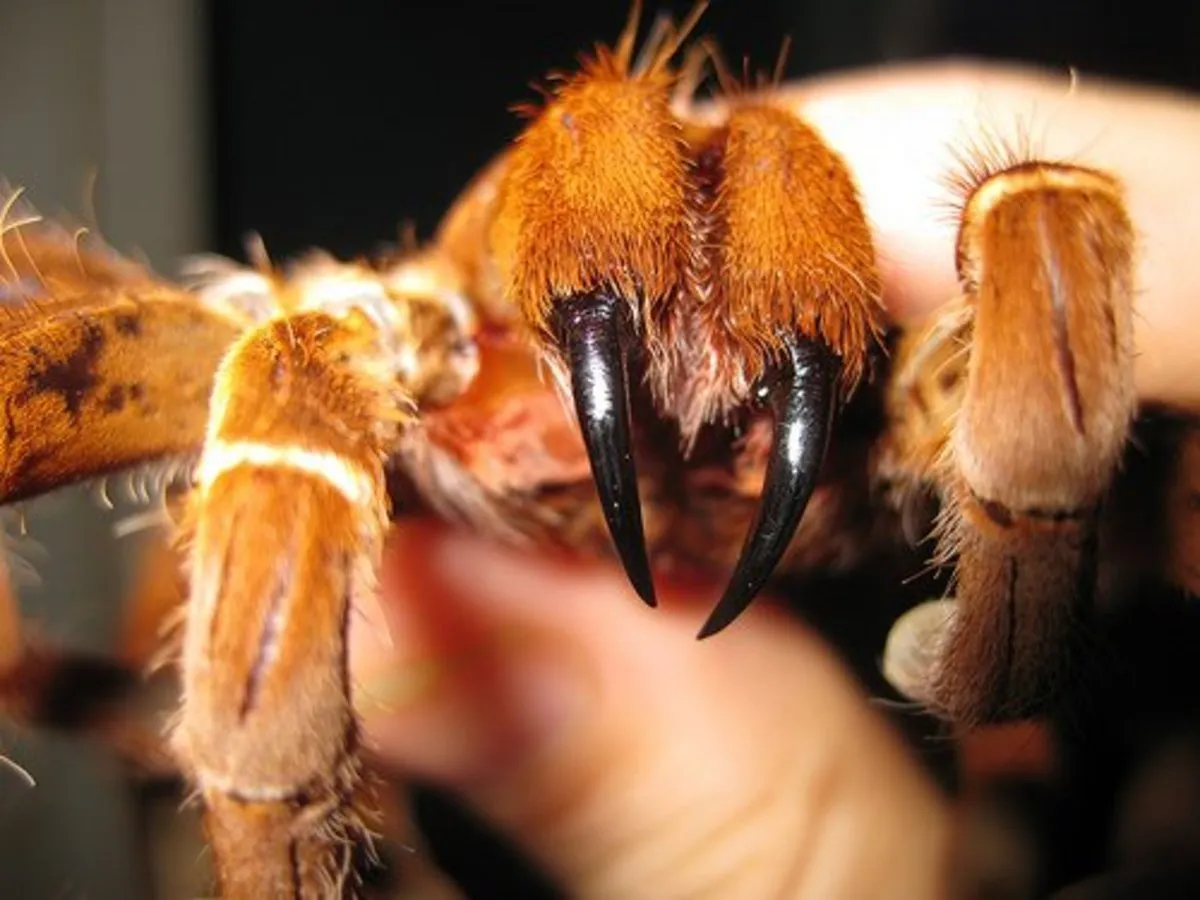Understanding Tarantula Bites
Tarantulas, while often perceived as intimidating, are generally not aggressive and prefer to avoid confrontation. However, when provoked or threatened, these large spiders can and will bite. Understanding tarantula bites involves knowing their anatomy, how the bite occurs, and the potential effects it can have on humans. This knowledge is crucial for effective first aid and pain management. The venom itself is typically not life-threatening to humans, but the bite can still cause discomfort and localized symptoms. It is also important to differentiate between a bite and the irritation caused by urticating hairs, which some tarantulas flick as a defense mechanism. While both can cause discomfort, they require different approaches for treatment. This article provides comprehensive information on how to deal with tarantula bites, ensuring you know how to react and what measures to take to find pain relief.
The Anatomy of a Tarantula Bite
To understand a tarantula bite, it’s important to know a bit about the spider’s anatomy. Tarantulas possess two fangs, called chelicerae, which are used to inject venom into their prey or, in the case of a bite, a perceived threat. The size of the fangs varies depending on the tarantula species, but they are generally quite large, capable of penetrating human skin. The venom is a complex mixture of enzymes and toxins designed to immobilize and begin digesting the spider’s prey. While the venom is not usually potent enough to cause severe harm to humans, the bite itself can still be painful due to the physical puncture and the introduction of foreign substances into the body. The chelicerae are connected to venom glands, which release the venom during a bite. The force with which the tarantula bites and the depth of penetration also play a role in the severity of the effects.
What Happens When a Tarantula Bites

When a tarantula bites, its fangs pierce the skin, injecting venom and potentially causing both physical and localized pain. The bite area often experiences immediate discomfort, including sharp pain, burning, and sometimes a throbbing sensation. The severity of the pain can vary depending on the species of tarantula, the amount of venom injected, and the individual’s sensitivity. After the initial pain, the area around the bite may begin to swell and become inflamed. Redness and warmth are common signs of inflammation. The venom begins to take effect, causing localized symptoms like muscle cramps, stiffness, and itching. In rare cases, more severe reactions can occur, particularly in individuals with allergies or sensitivities to the venom. The body’s response to the bite also involves the immune system, which works to neutralize the venom and repair the damaged tissues. The healing process typically takes several days to a week, depending on the severity of the bite and the effectiveness of the treatment.
Symptoms of a Tarantula Bite
Identifying the symptoms of a tarantula bite is important for providing prompt and effective care. The most common symptoms include immediate pain, which can range from mild to severe, at the bite site. You may experience redness and swelling around the bite. Itching and a burning sensation are also common. Some people may experience muscle cramps or stiffness, particularly near the bite area. Other symptoms could be, a tingling or numbness sensation, and in rare cases, nausea or dizziness. It is essential to monitor the bite area for any signs of a more severe reaction, such as difficulty breathing, severe swelling, or signs of an allergic reaction. If these symptoms appear, seek immediate medical attention. Most tarantula bites will result in localized symptoms that subside within a few days. However, prompt and appropriate treatment can help alleviate the pain and discomfort associated with the bite.
Immediate Actions to Take After a Bite
If you’ve been bitten by a tarantula, quick action can help to minimize the impact of the bite and ease the pain. The first thing to do is to remain calm. Try to identify the species of tarantula, if possible, but do not endanger yourself in the process. Next, wash the bite area thoroughly with mild soap and water. This helps to remove any residual venom or debris and prevent infection. After cleaning the bite, apply a cold compress or ice pack to the area. This can help reduce pain, swelling, and inflammation. Keep the affected limb elevated to further reduce swelling. It is also essential to monitor yourself for any signs of a severe reaction, such as difficulty breathing or widespread swelling. If you experience these symptoms, seek immediate medical attention. These immediate actions are crucial for managing the initial impact of the bite and promoting a quicker recovery.
Rinse the Bite Area

Rinsing the bite area with mild soap and water is a critical first step in treating a tarantula bite. This simple action serves several purposes. First, it helps to remove any venom or debris that may still be present on the skin’s surface. Second, it helps to prevent infection by washing away bacteria and other contaminants. Gently wash the bite area, making sure to clean the skin thoroughly without scrubbing aggressively. Avoid using harsh soaps, as these can irritate the skin and potentially worsen the inflammation. After washing, pat the area dry with a clean towel. This initial cleaning helps to create a cleaner environment for healing and can reduce the risk of secondary infections. This action is important because it forms the foundation for the subsequent stages of treatment.
Apply a Cold Compress
Applying a cold compress to the bite area is an effective method for alleviating pain and reducing inflammation. A cold compress, such as an ice pack or a cloth soaked in cold water, helps to constrict blood vessels and reduce swelling. The cold temperature also numbs the area, helping to ease the pain. Wrap the ice pack or cold cloth in a thin towel to prevent direct contact with the skin, which can cause frostbite. Apply the cold compress to the bite for 10-20 minutes at a time, several times a day. This technique helps manage pain and reduce the inflammatory response, which will make the bite less painful. By using a cold compress, you provide immediate relief and also create a favorable environment for healing, minimizing discomfort and improving the healing process.
Elevate the Affected Area
Elevating the affected limb can also help to minimize swelling and promote healing after a tarantula bite. By raising the bitten area above the heart, gravity helps reduce fluid buildup in the tissue, reducing inflammation. If the bite is on your arm, place your arm on a pillow while you are sitting or lying down. If the bite is on your leg, rest your leg on a cushion or pillow. Elevation can also provide some comfort, helping to reduce pressure on the affected area. This simple technique supports the body’s natural healing processes, and helps to expedite the recovery process.
Pain Management Techniques

Managing pain is a crucial aspect of treating a tarantula bite, as it significantly improves comfort and well-being. Several pain management techniques can be employed to relieve the discomfort. The use of cold compresses can provide immediate relief by numbing the area and reducing inflammation. Over-the-counter pain relievers like ibuprofen or acetaminophen can effectively manage pain and reduce inflammation. Home remedies, such as applying a paste of baking soda and water, may also offer some relief. It is essential to monitor the severity of the pain and adjust the pain management strategy accordingly. If the pain becomes severe or persists, seeking medical attention is important. Effective pain management not only alleviates discomfort but also promotes a faster recovery and enhances the quality of life during the healing period.
Over-the-Counter Pain Relievers
Over-the-counter (OTC) pain relievers can be extremely useful for managing the pain caused by a tarantula bite. Common OTC medications such as ibuprofen (Advil, Motrin) and acetaminophen (Tylenol) can help alleviate pain and reduce inflammation. Ibuprofen is a nonsteroidal anti-inflammatory drug (NSAID) that reduces both pain and swelling. Acetaminophen is a pain reliever that helps to reduce pain but does not have anti-inflammatory properties. Always follow the recommended dosage instructions on the product label. Avoid exceeding the recommended dose, as it can lead to side effects. If you have any existing health conditions or are taking other medications, consult a doctor or pharmacist before taking any OTC pain relievers. OTC pain relievers can provide accessible and effective relief for mild to moderate pain, contributing to a more comfortable recovery.
Home Remedies for Pain Relief
Various home remedies can help alleviate the pain and discomfort caused by a tarantula bite. Applying a paste of baking soda and water to the bite area may help to neutralize the venom and reduce inflammation. Aloe vera, known for its soothing properties, can be applied to the bite to reduce pain and promote healing. Some people find relief by applying a paste of crushed plantain leaves. It is important to use clean, sterile materials when applying these remedies. While these home remedies can provide some relief, they should not replace medical advice or treatment if the pain is severe or if any signs of a severe reaction are present. If you are unsure, consult a doctor before trying any home remedies, especially if you have any underlying health conditions or allergies.
When to Seek Medical Attention

Knowing when to seek medical attention after a tarantula bite is critical for ensuring your safety and well-being. While most tarantula bites cause only mild symptoms, there are certain situations that warrant immediate medical care. Seek medical attention if you experience severe pain that is not relieved by over-the-counter medications, or if the pain worsens. If you have difficulty breathing, experience swelling of the face, lips, or throat, or develop a rash or hives, this could indicate a severe allergic reaction (anaphylaxis), and you must seek immediate medical assistance. If the bite area shows signs of infection, such as increased redness, warmth, pus, or fever, medical attention is necessary. People with pre-existing health conditions, such as allergies or asthma, may also need medical care more urgently. Early medical intervention can help prevent complications and improve the outcome of the bite.
Signs of a Severe Reaction
Recognizing the signs of a severe reaction to a tarantula bite is crucial for immediate intervention. Severe allergic reactions, also known as anaphylaxis, require emergency medical care. Symptoms of a severe reaction may include difficulty breathing or wheezing, swelling of the face, lips, tongue, or throat, dizziness or loss of consciousness, rapid heartbeat, and a widespread rash or hives. Other serious signs are severe pain that is not relieved by standard pain management techniques, as well as signs of infection. If any of these symptoms appear, call for emergency medical services immediately. Quick action can prevent life-threatening complications and ensure that you receive appropriate care, such as the administration of epinephrine and other life-saving treatments.
What to Expect at the Doctor
When you go to the doctor for a tarantula bite, the medical team will evaluate your condition and determine the best course of treatment. The doctor will take a detailed history, asking about the bite, your symptoms, and any pre-existing health conditions or allergies. The doctor will examine the bite area, looking for signs of infection, allergic reactions, or other complications. Treatment may include administering pain medication, antihistamines to reduce allergic reactions, or antibiotics if there are signs of infection. In severe cases, the doctor might administer epinephrine to treat anaphylaxis. You might be given instructions for home care, including how to care for the bite area, take medications, and monitor your symptoms. Follow the doctor’s instructions carefully, and do not hesitate to ask questions or raise concerns. They will also assess your need for a tetanus shot if it is not up to date.
Preventing Tarantula Bites

Preventing tarantula bites involves taking precautions and adopting safe handling practices. One of the most important things to do is to avoid contact with tarantulas in their natural habitats. If you live in an area where tarantulas are common, be cautious when working outdoors, especially in areas where they might be present, such as under rocks, logs, or in burrows. If you own a tarantula as a pet, handle it with care, use appropriate tools, and follow expert handling advice. Regularly inspect the tarantula’s enclosure for any signs of stress or escape attempts. Being aware of potential risks, and implementing safe handling techniques, significantly decreases the likelihood of being bitten and ensures a safer interaction with these animals.
Safe Handling Practices
If you own a tarantula or need to handle one, safe handling practices are essential. Always approach the tarantula calmly and avoid sudden movements or loud noises, which can startle the spider. Use a long pair of tongs or a specialized handling tool to move the tarantula, minimizing direct contact and reducing the risk of a bite. If you need to handle the tarantula directly, do so over a soft surface, such as a bed or a large container, to prevent injury if the spider falls. Support the tarantula’s body, ensuring it does not feel threatened. After handling, wash your hands thoroughly with soap and water. By practicing these techniques, you create a safer environment for both you and the tarantula, reducing the chances of bites and promoting respectful interactions.
Avoiding Tarantula Habitats
To avoid tarantula bites, it’s important to be aware of their habitats and take precautions in areas where they are known to live. Tarantulas are frequently found in warm, dry environments, such as deserts, grasslands, and forests. When hiking or working outdoors in these areas, wear protective clothing, including long sleeves, pants, and closed-toe shoes. Be especially careful when overturning rocks or logs, as tarantulas often hide underneath. Use a flashlight at night to inspect the ground before stepping, as tarantulas are more active during the evening. Educate yourself about the tarantula species native to your region and their behaviors. By being vigilant and taking necessary precautions, you can drastically reduce your risk of encountering a tarantula and suffering a bite.
